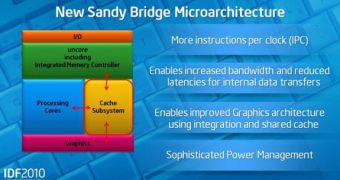The web has been veritably swarming with talk of Intel's next-generation architecture and rumors about when and where the market will eventually see it in action. These chips promise to better perform in practically all areas possible and, while they will most likely need a new platform to start off, they will definitely enhance performance of all products they are used in, according to the Santa Clara, California-based chip maker. Unfortunately, besides rumors, leaks and meager disclosures on the manufacturer's part, there wasn't much to go on, at least not until recently, when the chip developer disclosed some details at the Intel Developer Forum in Beijing.
Apparently, the first central processing units based on this advanced architecture will enter production later this year, which means that actual availability should come sometime in early 2011. These chips are being designed on the 32nm manufacturing process technology and promise to bring about a significant number of improvements, compared to current-generation parts, in practically all areas that CPUs can address.
One improvement will be the inclusion of AES New Instructions (AES-NI), which will significantly speed up encryption and decryption tasks, so end-users can expect future machines to be more secure. Another thing is that, except for high-end models, all Sandy Bridge chips will come with the company's sixth-generation graphics core.
There is a certain technological advancement that may carry more significance, namely the support for Advanced Vector Extension (Intel AVX) instructions. Basically, what these instructions accomplish is accelerate video, image and audio processing. This is an important factor, especially considering that the current CPUs' inability to complete such tasks in a timely fashion is part of the reason why ATI's and, especially, NVIDIA's professional graphics adapters (thanks to the CUDA technology) are so well received on the professional market.
Such video boards handle video conversions much easier and faster than central processors. Of course, there is little chance of the Sandy Bridge jeopardizing these adapters' position, but, combined, they should allow an even higher performance in professional applications.
The Sandy Bridge architecture will spawn offspring with two to four cores for mainstream and high-end desktops and notebooks, as well as for LV (low voltage) and ULV (ultra low voltage) laptops.

 14 DAY TRIAL //
14 DAY TRIAL //